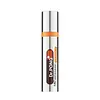What's inside
What's inside
 Key Ingredients
Key Ingredients

 Benefits
Benefits

 Concerns
Concerns

No concerns
 Ingredients Side-by-side
Ingredients Side-by-side

Water
Skin ConditioningNiacinamide
SmoothingPropylene Glycol
HumectantButylene Glycol
HumectantCyclopentasiloxane
EmollientCaprylic/Capric Triglyceride
MaskingCetearyl Olivate
Alcohol Denat.
AntimicrobialAscorbic Acid
Antioxidant3-O-Ethyl Ascorbic Acid
Skin ConditioningAscorbyl Glucoside
AntioxidantCaprylyl 2-Glyceryl Ascorbate
AntioxidantFerulic Acid
AntimicrobialAcetyl Tetrapeptide-2
Skin ConditioningNonapeptide-1
Skin ConditioningPanthenol
Skin ConditioningCeramide NP
Skin ConditioningCeramide AP
Skin ConditioningCeramide As
Skin ConditioningCeramide EOP
Skin ConditioningCeramide Ns
Skin ConditioningHyaluronic Acid
HumectantHydrolyzed Hyaluronic Acid
HumectantSodium Acetylated Hyaluronate
HumectantHydrolyzed Sodium Hyaluronate
Skin ConditioningSodium Hyaluronate
HumectantHydroxypropyltrimonium Hyaluronate
Sodium Hyaluronate Crosspolymer
HumectantPotassium Hyaluronate
Skin ConditioningTocopheryl Acetate
AntioxidantGlucose
HumectantSorbitan Olivate
EmulsifyingPropanediol
SolventChondrus Crispus Extract
Skin ConditioningStyrene/Acrylates Copolymer
Allantoin
Skin ConditioningPhenoxyethanol
PreservativeGlyceryl Stearate
EmollientTrideceth-50
CleansingCetearyl Alcohol
EmollientPEG-100 Stearate
Chlorphenesin
AntimicrobialBHT
AntioxidantDisodium EDTA
Sodium Metabisulfite
AntioxidantHydroxyethyl Acrylate/Sodium Acryloyldimethyl Taurate Copolymer
Emulsion StabilisingParfum
MaskingAcacia Senegal Gum
MaskingXanthan Gum
EmulsifyingGlycerin
HumectantSodium Lauryl Sulfate
CleansingStyrene
PerfumingDipropylene Glycol
HumectantHydrogenated Lecithin
EmulsifyingMethacrylic Acid
1,2-Hexanediol
Skin ConditioningCholesterol
EmollientCaprylyl Glycol
EmollientEthylhexylglycerin
Skin ConditioningWater, Niacinamide, Propylene Glycol, Butylene Glycol, Cyclopentasiloxane, Caprylic/Capric Triglyceride, Cetearyl Olivate, Alcohol Denat., Ascorbic Acid, 3-O-Ethyl Ascorbic Acid, Ascorbyl Glucoside, Caprylyl 2-Glyceryl Ascorbate, Ferulic Acid, Acetyl Tetrapeptide-2, Nonapeptide-1, Panthenol, Ceramide NP, Ceramide AP, Ceramide As, Ceramide EOP, Ceramide Ns, Hyaluronic Acid, Hydrolyzed Hyaluronic Acid, Sodium Acetylated Hyaluronate, Hydrolyzed Sodium Hyaluronate, Sodium Hyaluronate, Hydroxypropyltrimonium Hyaluronate, Sodium Hyaluronate Crosspolymer, Potassium Hyaluronate, Tocopheryl Acetate, Glucose, Sorbitan Olivate, Propanediol, Chondrus Crispus Extract, Styrene/Acrylates Copolymer, Allantoin, Phenoxyethanol, Glyceryl Stearate, Trideceth-50, Cetearyl Alcohol, PEG-100 Stearate, Chlorphenesin, BHT, Disodium EDTA, Sodium Metabisulfite, Hydroxyethyl Acrylate/Sodium Acryloyldimethyl Taurate Copolymer, Parfum, Acacia Senegal Gum, Xanthan Gum, Glycerin, Sodium Lauryl Sulfate, Styrene, Dipropylene Glycol, Hydrogenated Lecithin, Methacrylic Acid, 1,2-Hexanediol, Cholesterol, Caprylyl Glycol, Ethylhexylglycerin
Water
Skin ConditioningAscorbic Acid
AntioxidantPropanediol
SolventPentylene Glycol
Skin ConditioningHyaluronic Acid/Polyisopropylacrylamide Copolymer
HumectantButylene Glycol
HumectantGlutathione
Sodium Hydroxide
BufferingGluconolactone
Skin ConditioningSilanediol Salicylate
EmollientSodium Citrate
BufferingAdenosine
Skin ConditioningCyclodextrin
AbsorbentCitric Acid
BufferingFullerenes
AntimicrobialPvp
Emulsion StabilisingPhenoxyethanol
PreservativeEDTA
Ingredients Explained
These ingredients are found in both products.
Ingredients higher up in an ingredient list are typically present in a larger amount.
Ascorbic Acid is is pure Vitamin C. This form makes up the largest amount of vitamin C found naturally in our skin.
Not only is vitamin C great for your overall health and immune system, it also has plenty of benefits on your skin.
Vitamin C is best used for brightening skin. It improves dark spots, acne scars, and hyperpigmentation. This is because it blocks the process of skin darkening when exposed to UV.
Remember: Vitamin C should not replace sunscreen!
Your skin uses vitamin C to build collagen. Collagen is one key component in having a strong skin barrier and plump skin. Vitamin C also plays a role in regulating collagen, thus making it effective in improving wrinkles and fine lines.
Ascorbic acid shows potent antioxidant activity. As an antioxidant, it helps fight free-radicals. Free-radicals are molecules that may damage your skin cells. These antioxidants also protect skin against UV damage.
The best formulations include Vitamin E and/or ferulic acid. These two ingredients help stabilize and provide a boost in the benefits of ascorbic acid. This is because ascorbic acid becomes unstable when exposed to UV and air. In fact, you can tell your ascorbic acid has oxidized when it turns an orange-yellow color.
Ascorbic acid is generally compatible with other ingredients. However, using ascorbic acid with other active ingredients might cause irritation. Two ingredients: copper ions and benzoyl peroxide, will inactivate ascorbic acid completely.
Read more about other types of Vitamin C:
Foods rich with vitamin C include oranges, strawberries, broccoli, bell peppers, and more. When consuming Vitamin C, your skin receives a portion of the nutrients.
Learn more about Ascorbic AcidButylene Glycol (or BG) is used within cosmetic products for a few different reasons:
Overall, Butylene Glycol is a safe and well-rounded ingredient that works well with other ingredients.
Though this ingredient works well with most skin types, some people with sensitive skin may experience a reaction such as allergic rashes, closed comedones, or itchiness.
Learn more about Butylene GlycolPhenoxyethanol is a preservative that has germicide, antimicrobial, and aromatic properties. Studies show that phenoxyethanol can prevent microbial growth. By itself, it has a scent that is similar to that of a rose.
It's often used in formulations along with Caprylyl Glycol to preserve the shelf life of products.
Propanediol is an all-star ingredient. It softens, hydrates, and smooths the skin.
It’s often used to:
Propanediol is not likely to cause sensitivity and considered safe to use. It is derived from corn or petroleum with a clear color and no scent.
Learn more about PropanediolWater. It's the most common cosmetic ingredient of all. You'll usually see it at the top of ingredient lists, meaning that it makes up the largest part of the product.
So why is it so popular? Water most often acts as a solvent - this means that it helps dissolve other ingredients into the formulation.
You'll also recognize water as that liquid we all need to stay alive. If you see this, drink a glass of water. Stay hydrated!
Learn more about Water